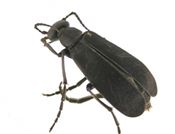What Alfalfa Hay Producers And Buyers Should Know About Blister Beetles

Figure 1. Blister beetle - note narrow neck between head and abdomen.
DR. LEE TOWNSEND
LEXINGTON, KY.
Blister beetles are plant-feeding insects that contain cantharidin, a toxic defensive chemical that protects them from predators. Accidentally crushing a beetle against the skin can result in a painful blister, the source of the insect’s common name. In sufficient quantity, cantharidin in the bodies of living or dead blister beetles can be toxic, especially to horses. In some cases sheep and cattle may be affected.
Blister Beetle Poisoning
Cantharidin is very stable and remains toxic in dead beetles. Animals may be poisoned by eating crushed beetles in cured hay. The severity of the reaction, ranging from temporary poisoning to reduced digestive ability to death, depends upon the amount of cantharidin ingested and the size and health of the animal.
Poisoning symptoms in horses usually appear within hours and include irritation and inflammation of the digestive and urinary tracts, colic, and straining during frequent urination. This irritation may also result in secondary infection and bleeding. In addition, calcium levels in horses may be drastically lowered and heart muscle tissue can be damaged. Since animals can die within 72 hours, it is imperative to contact a veterinarian as soon as blister beetle poisoning is suspected.
Blister Beetle Description
Blister beetles have long (3/4 to 1 1/4 inch) narrow bodies, broad heads, and antennae that are about one-third the length of their entire bodies (Figure 1). The front wings are soft and flexible in contrast to the hard front wings of most beetles. Black, striped, and margined blister beetles occur in Kentucky, but large populations are not common. They can be found feeding now through August. Blister beetles are especially attracted to and feed on flowers. An aggregation pheromone released by the insects as they feed results in accumulations of beetles or “hot spots,” often along field margins.
Blister Beetle Development
Female blister beetles lay clusters of eggs in the soil in late summer. The small, active larvae that hatch from these eggs crawl over the soil surface and enter cracks in search of grasshopper egg pods, which are deposited in the soil. After finding an egg mass, blister beetle larvae become immobile and spend the rest of their developmental time as legless grubs. Blister beetles will not lay eggs in hay and larvae do not feed upon or develop in hay bales.
Tips for Hay Producers
• Learn to recognize blister beetles and understand their behavior. A proactive preventive program will reduce the chances of infested hay.
• Blister beetles are not active when the first cutting is taken in Kentucky. For high quality hay for horses, harvest at the late bud stage or when the first flowers open.
• Blister beetles are attracted to blooms. Manage harvest intervals to minimize flowering of alfalfa or weeds. Practice good broadleaf weed management. If flowering plants are present at harvest, inspect them carefully for blister beetles.
• Avoid crimping hay during harvest. Straddle cut swaths to avoid crushing beetles with tractor tires.
• There is no efficient way to inspect baled hay carefully enough to be sure that it is free of blister beetles.
Tips for Horse Owners
• Buy first cutting hay; blister beetles are not active at that time.
• Buy from local sources.
• Develop a relationship with your hay producer so you know their production practices and hay quality. ∆
DR. LEE TOWNSEND: Extension Entomologist, University of Kentucky